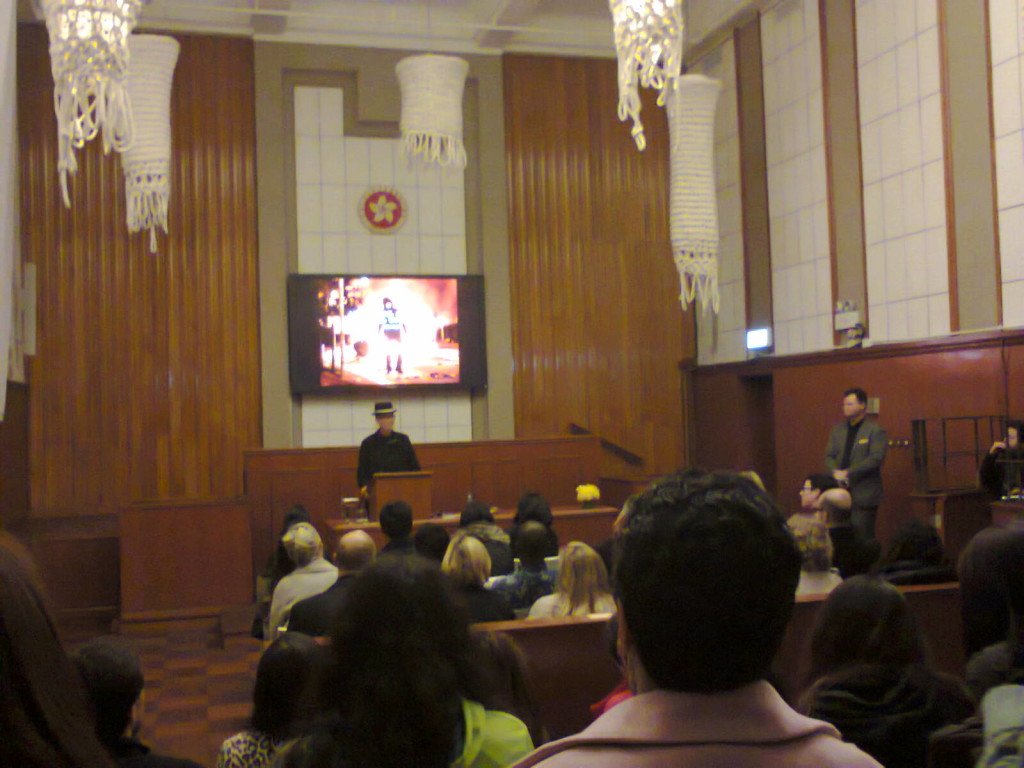Hong Kong, Feb 17, 2016 http://www.scad.edu/event/2016-02-17-kacey-wong-lecture-art-resistance
Kacey Wong is very much a ‘media artist’ in the way how he is able to attract audiences through his protest artworks slash media stunts. In all the works, he tries to give a commentary on the social and political circumstances in Hong Kong. Currently, he is a professor at Hong Kong Polytechnic University, the applied-art direction also hinting at his undergraduate studies in architecture.
The lecture was interesting already through its setting in the building that used to be a court (Kowloon Magistrate). The whole building has been left in a close to original state including interior architecture, thus it was really like visiting a Hong Kong court. Currently the building is leased out to a subsidiary of a private American art school – Savannah College of Art and Design (SCAD). SCAD did a wonderful job at designing the interior, augmenting the British-colonial architecture with some significant yet not overwhelming artistic touches. Yet SCAD seems also a very isolated place, closed to the public except for a few events per year (as this one). SCAD also has its own history of controversies, which does not make it look like the most “democratic” institution.
The topic of Kacey Wong’s political protest art, the building of an ex-Hong Kong court and SCAD institution provided a very “interesting” mix to start with.
Kacey Wong presented a number of his most popular works – his floating mini-flat on Victoria Harbour, the mobile bicycle-home, as well as his actual “protest art”, i.e. mobile sculptures he made for the “traditional” July 1st protest in Hong Kong (the day Hong Kong SAR has been returned to People’s Republic of China by the United Kingdom in 1997). As such, the presentation has not been that much surprising, and it gave me the feeling that SCAD invited him to explain a bit about the “world out there” to their undergrad students. This feeling was supported by Wong’s interlaced remarks and once-sentence wisdoms addressed to the SCAD students (“how to use one artwork to accomplish three assignments”) and SCAD faculty (“this is a good assignment to give to your students”). This seemed to contradict the official aim of the lecture as one of the public programs at SCAD aimed at an audience outside of the school. Generally, Wong’s lecture style mirrored that of his artworks, and it mainly consisted of an arrangement of short, sometimes funny, self-contained statements that did not express much more that was is already known. This approach seemed to be consistent with Wong’s art of resistance methodology, that has been proved as usable through the success of his practice, but it also raised the question of whether the art has been made to resist and induce change or to attract attention in order to build the artist’s own career.
In the end it seemed that more than a discussion on political and protest art, the talk explained how a popular context can be used to source an audience and how art can be used for self-promotion and brand building. Definitely a very useful and necessary topic for anyone working in the art world or creative industry, showing another side of politics, the politics of survival in the art world, that only loosely relate to the lofty ideals of political art.
